Papers by Alona Zilberberg
The Journal of Liquid Biopsy, Oct 31, 2023
Breast Cancer Research, Nov 20, 2014

Cancer Research, Apr 1, 2012
Background: Previous studies in our lab have shown that CD24 is a potential oncogene in the colon... more Background: Previous studies in our lab have shown that CD24 is a potential oncogene in the colon. CD24, a mucin-like glycoprotein, is overexpressed in 90% of colorectal cancer (CRC) tumors at a fairly early stage in the multistep process of CR carcinogenesis (Sagiv et al., Gastroenterology, 2006). We have also shown that CD24 downregulation by shRNA interference (Sagiv et al., Can Res, 2008) or anti-CD24 mAb targeting (Shapira et al., Gastroenterology, 2011) retarded tumorigenicity of human CRC cell lines and/or reduced tumor volume in nude mice. The APCmin/+ is a popular animal model for studies of human colon carcinogenesis and the molecular changes associated with neoplasia in this system have been partially characterized. These mice have a germline nonsense mutation at codon 850 of the APC gene and spontaneously develop hundreds of polyps, mostly in the small intestine at the age of 10-12 weeks. Aim: To validate the importance of CD24 in intestinal carcinogenesis using a transgenic mouse model with a double knockout (KO) of CD24−/+ /CD24+/− and APCMin/+ alleles. Methods: We generated the CD24−/+/APCMin/+ double KO by crossing the mice with each of the single gene knockouts, in order to obtain both CD24+/−/APCMin/+ and CD24−/+ APCMin/+ genotypes. The double KO mice were followed up thrice a week and sacrificed at 12 weeks of age. Tumors from the entire small and large intestine were counted and verified by histological analysis Results: There was almost a complete absence of polyps in the small intestine in APCMin/+/CD24+/− double heterozygotes compared to that of the parental APCMin/+, CD24+/+ animals: 273±55.4 vs. 6±1.7 polyps, respectively (P=0.0001). APCMin/+and CD24−/+ homozygotes showed a striking lack of polyps (P< 0.0001). This reduction occurred in all sections of the small intestine. Histophatological analysis confirmed the absence of malignant lesions in the double KO mice as compared to the parental mice. Conclusions: 1. A deficiency of only one CD24 allele is sufficient to suppress almost completely polyp formation in the APCMin/+ mice that normally develop hundreds of polyps. 2. Although the mechanism/s underlying the pathophysiologic role of CD24 in the development of CRC are still unknown, these studies suggest that CD24 plays a critical role in the proliferation and progression of CRC and is a potential important target for the prevention and treatment of intestinal neoplasia. Citation Format: {Authors}. {Abstract title} [abstract]. In: Proceedings of the 103rd Annual Meeting of the American Association for Cancer Research; 2012 Mar 31-Apr 4; Chicago, IL. Philadelphia (PA): AACR; Cancer Res 2012;72(8 Suppl):Abstract nr 1338. doi:1538-7445.AM2012-1338
British Journal of Pharmacology, Oct 11, 2011
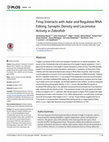
PLoS genetics, 2015
Fragile X syndrome (FXS) is the most frequent inherited form of mental retardation. The cause for... more Fragile X syndrome (FXS) is the most frequent inherited form of mental retardation. The cause for this X-linked disorder is the silencing of the fragile X mental retardation 1 (fmr1) gene and the absence of the fragile X mental retardation protein (Fmrp). The RNA-binding protein Fmrp represses protein translation, particularly in synapses. In Drosophila, Fmrp interacts with the adenosine deaminase acting on RNA (Adar) enzymes. Adar enzymes convert adenosine to inosine (A-to-I) and modify the sequence of RNA transcripts. Utilizing the fmr1 zebrafish mutant (fmr1-/-), we studied Fmrp-dependent neuronal circuit formation, behavior, and Adar-mediated RNA editing. By combining behavior analyses and live imaging of single axons and synapses, we showed hyperlocomotor activity, as well as increased axonal branching and synaptic density, in fmr1-/- larvae. We identified thousands of clustered RNA editing sites in the zebrafish transcriptome and showed that Fmrp biochemically interacts with t...
Breast Cancer Research, 2014
Journal of Hepatology, 2012

Cancer Research, 2012
Background: Previous studies in our lab have shown that CD24 is a potential oncogene in the colon... more Background: Previous studies in our lab have shown that CD24 is a potential oncogene in the colon. CD24, a mucin-like glycoprotein, is overexpressed in 90% of colorectal cancer (CRC) tumors at a fairly early stage in the multistep process of CR carcinogenesis (Sagiv et al., Gastroenterology, 2006). We have also shown that CD24 downregulation by shRNA interference (Sagiv et al., Can Res, 2008) or anti-CD24 mAb targeting (Shapira et al., Gastroenterology, 2011) retarded tumorigenicity of human CRC cell lines and/or reduced tumor volume in nude mice. The APCmin/+ is a popular animal model for studies of human colon carcinogenesis and the molecular changes associated with neoplasia in this system have been partially characterized. These mice have a germline nonsense mutation at codon 850 of the APC gene and spontaneously develop hundreds of polyps, mostly in the small intestine at the age of 10-12 weeks. Aim: To validate the importance of CD24 in intestinal carcinogenesis using a transg...
British Journal of Pharmacology, 2011
International Journal of Cancer, 2014
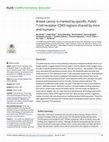
PLOS Computational Biology, Jan 19, 2021
The partial success of tumor immunotherapy induced by checkpoint blockade, which is not antigen-s... more The partial success of tumor immunotherapy induced by checkpoint blockade, which is not antigen-specific, suggests that the immune system of some patients contain antigen receptors able to specifically identify tumor cells. Here we focused on T-cell receptor (TCR) repertoires associated with spontaneous breast cancer. We studied the alpha and beta chain CDR3 domains of TCR repertoires of CD4 T cells using deep sequencing of cell populations in mice and applied the results to published TCR sequence data obtained from human patients. We screened peripheral blood T cells obtained monthly from individual mice spontaneously developing breast tumors by 5 months. We then looked at identical TCR sequences in published human studies; we used TCGA data from tumors and healthy tissues of 1,256 breast cancer resections and from 4 focused studies including sequences from tumors, lymph nodes, blood and healthy tissues, and from single cell dataset of 3 breast cancer subjects. We now report that mice spontaneously developing breast cancer manifest shared, Public CDR3 regions in both their alpha and beta and that a significant number of women with early breast cancer manifest identical CDR3 sequences. These findings suggest that the development of breast cancer is associated, across species, with biomarker, exclusive TCR repertoires.
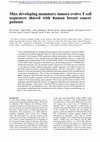
Cancer immunotherapy by checkpoint blockade proves that an effective immune response to a tumor c... more Cancer immunotherapy by checkpoint blockade proves that an effective immune response to a tumor can be induced clinically. However, little is known about the evolution of tumorassociated T-cell receptor (TCR) repertoires without intervention. Here we studied TCR repertoire evolution in mice spontaneously developing mammary tumors; we sequenced peripheral blood alpha and beta TCRs of CD4 + CD62L + CD44-T cells monthly for 8 months in 10 FVB/NJ mice transgenic at the Erbb2 locus, all developing tumors; 5 FVB/NJ mice without the transgene were age-matched controls. Sequences were either private (restricted to one mouse) or public (shared among mice); public sequences were either exclusive to the tumor group or inclusive among different groups. We now report that 1), public AA sequences were each encoded by many different nucleotide sequences (NT) recombinations (convergent recombination; CR); 2) mice developing tumors evolved tumor-exclusive public sequences, derived initially from private or from inclusive public sequences; and 3) tumor-exclusive public sequences in mice were also present among published public TCR sequences from human breast cancer patients. These cross-species tumor-exclusive TCR sequences manifested high CR; but the AA sequences shared by mice and humans did not share NT sequences. Thus, tumor-exclusive TCR AA sequences across species are selected from different NT recombination events. The roles of tumor-exclusive TCR repertoires in advancing or inhibiting tumor development and the effects of tumor immunotherapy on these T cells remain to be seen.
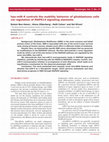
Oncotarget, Dec 21, 2015
Background: Glioblastoma Multiforme (GBM) is the most common and lethal primary tumor of the brai... more Background: Glioblastoma Multiforme (GBM) is the most common and lethal primary tumor of the brain. GBM is associated with one of the worst 5-year survival rates among all human cancers, despite much effort in different modes of treatment. Results: Here, we demonstrate specific GBM cancer phenotypes that are governed by modifications to the MAPAKAP network. We then demonstrate a novel regulation mode by which a set of five key factors of the MAPKAP pathway are regulated by the same microRNA, hsa-miR-9. We demonstrate that hsa-miR-9 overexpression leads to MAPKAP signaling inhibition, partially by interfering with the MAPK14/MAPKAP3 complex. Further, hsa-miR-9 overexpression initiates rearrangement of actin filaments, which leads us to hypothesize a mechanism for the observed phenotypic shift. Conclusion: The work presented here exposes novel microRNA features and situates hsa-miR-9 as a therapeutic target, which governs metastasis and thus determines prognosis in GBM through MAPKAP signaling.

Annals of Oncology, Sep 1, 2020
Background: Cytomegalovirus (CMV) antigens have been reported in over 90% of GBM tumors. We have ... more Background: Cytomegalovirus (CMV) antigens have been reported in over 90% of GBM tumors. We have completed the first portion of an ongoing phase I/IIa clinical trial for recurrent GBM patients using CMV gB/pp65 enveloped virus-like particles (eVLPs) formulated with GM-CSF and administered intradermally. We have reported that tumor responses were observed only among Vaccine Responders, based on increases in CMV-specific IFN-g ELISPOT responses, which translated to a 6-month improvement in median overall survival. We evaluated the HLA restriction and TCR repertoires of patients to determine if either correlated with those patients likely to observe tumor response and clinical benefit. Methods: PBMC samples prior to treatment were available for 17 patients, with a variable number of additional samples obtained from each patient obtained, two weeks after each monthly treatment with VBI-1901. TCR repertoire analysis was performed on a total of 29 PBMC samples from 6 Vaccine Responders (range 3-9 samples/patient, median 4.5) and on 29 PBMC samples from 11 Non-responders (range 1-4 samples/patient, median 3). Results: Quantitative analysis of the TCR repertoire suggests a trend towards a reduced number of unique CDR3 sequences in the TCR b chain over time in Vaccine Responders vs. Non-Responders, associated with a modest reduction in TCR b chain diversity over time. HLA class I alleles known to present CMV pp65 antigens were present in the majority of patients, regardless of whether they were Vaccine Responders or Non-Responders. Among the 4 patients with tumor responses, the HLA-B*0702 allele, known to present both CMV pp65 and IE-1 peptides, was present in 3/ 4 patients whereas it was present in only 2/13 patients with progressive disease. Conclusions: TCR repertoire analysis suggests a narrowing of the T cell repertoire with repeat vaccination, and HLA analysis suggests that epitope spreading to a CMV antigen (IE-1) not contained in VBI-1901 may be associated with tumor responses in patients that respond to the vaccine. Clinical trial identification: NCT03382977. Legal entity responsible for the study: VBI Vaccines.
iScience, Feb 1, 2021
Response to ICI is associated with pretreatment TCR repertoire in mice TCR repertoire goes throug... more Response to ICI is associated with pretreatment TCR repertoire in mice TCR repertoire goes through distinct, ICIdependent changes with time Tumor size and its response to ICI can be tracked by TCR repertoire metrics A single time point is found to be a focal point of the immune response
Oncotarget, Feb 18, 2014
This is an open-access article distributed under the terms of the Creative Commons Attribution Li... more This is an open-access article distributed under the terms of the Creative Commons Attribution License, which permits unrestricted use, distribution, and reproduction in any medium, provided the original author and source are credited.
Frontiers in Immunology, Dec 11, 2018

The prediction of patients’ response to checkpoint immunotherapy is currently imprecise. Here, we... more The prediction of patients’ response to checkpoint immunotherapy is currently imprecise. Here, we show that a measurement of the T-cell repertoire, from peripheral blood of mice, is enough to predict which mice would or would not respond to anti-PD1 treatment. To show this, we used a syngeneic orthotopically implanted CL261 glioma-bearing mouse model. We followed the mice over the timeline of tumor implantation and checkpoint immunotherapy, with blood samples on days 0, 7, 21, 35, 49, and 63. Since the (syngeneic) implanted tumor is bioluminescent, we were able to monitor tumor size using bioluminescence imaging (up to 9 measures, 1 measure per week), up to day 63 post-tumor inoculation. We then produced more than 130 T-cell receptor libraries for the alpha and beta chains and sequenced these libraries to produce a data set of the dynamics of the T-cell repertoire during tumor progression and during response to treatment. In this model, only 30% of animals respond to treatment, which allowed us to look at the repertoires of two distinct groups: responders and nonresponders. Using machine learning, we were able to build a model that allows us to tag, in a validation set, responders and nonresponders, thereby predicting response. Citation Format: Hagit Philip, Tom Snir, Miri Gordin, Yoav Wigelman, Alona Zilberberg, Sol Efroni. The T-cell repertoire as a biomarker for response to anti PD-1 immunotherapy [abstract]. In: Proceedings of the AACR Special Conference on Tumor Immunology and Immunotherapy; 2019 Nov 17-20; Boston, MA. Philadelphia (PA): AACR; Cancer Immunol Res 2020;8(3 Suppl):Abstract nr B39.
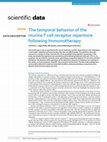
Scientific Data, Feb 23, 2023
Unlike the genetic code, the TCR repertoire is dynamic; its state, made readable with RNA sequenc... more Unlike the genetic code, the TCR repertoire is dynamic; its state, made readable with RNA sequencing, indicates the current status of the immune system. As such, several methods have been developed to quantify the TCR repertoire and its diverse components 14-16 , and many computational and analytical tools are constantly being developed and used to analyze these repertoires 17-19. Many works have highlighted the importance of a diverse TCR repertoire for the immune system to perform optimally 1,20 , and while these works track and document changes to the repertoire, the supporting data is limited to pre-and post-treatment time points at best. Additionally, since a phenotypical change, such as reduction in tumor size, can occur some time after the peak of the immunological response, it can be difficult to create a snapshot of the immune state at the most relevant time. Moreover, the high variability in the favorable reaction of cancers to immunotherapy, makes it even challenging for researcher to quantify the true dynamics of the immune response 21 .











Uploads
Papers by Alona Zilberberg